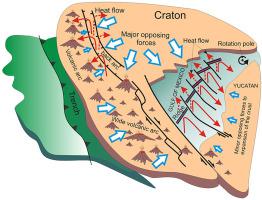当前位置:
X-MOL 学术
›
J. South Am. Earth Sci.
›
论文详情
Our official English website, www.x-mol.net, welcomes your
feedback! (Note: you will need to create a separate account there.)
Subduction-related Jurassic volcanism in the Mesa Central province and contemporary Gulf of Mexico opening
Journal of South American Earth Sciences ( IF 1.7 ) Pub Date : 2020-10-01 , DOI: 10.1016/j.jsames.2020.102961 José Rafael Barboza-Gudiño , Aurora Zavala-Monsiváis , Valentina Castellanos-Rodríguez , Diego Jaime-Rodríguez , Carolina Almaraz-Martínez
Journal of South American Earth Sciences ( IF 1.7 ) Pub Date : 2020-10-01 , DOI: 10.1016/j.jsames.2020.102961 José Rafael Barboza-Gudiño , Aurora Zavala-Monsiváis , Valentina Castellanos-Rodríguez , Diego Jaime-Rodríguez , Carolina Almaraz-Martínez

|
Abstract Jurassic volcanic successions in the Mesa Central (central Mexico) are considered as remnants of the Early-Middle Jurassic Nazas volcanic province, which is interpreted either, as a volcanic arc, result of the eastward subduction of paleo-Pacific plate underneath north-central Mexico or as a volcanic belt influenced by transtension related to the breakup of Pangea and subduction from the paleo-Pacific domain. We present new geochemical and geochronological data of Jurassic volcanic rocks exposed in Durango, Coahuila, Zacatecas, San Luis Potosi and Nuevo Leon that confirm observations from previously reported localities in northeastern Mexico, a subduction signature for all studied rocks and ages of volcanism between 191 and 165 Ma (U–Pb, zr, LA-ICP-MS). Initial eNd values (t = 180 Ma) lye by −4.56 to 0.06 for samples from Real de Catorce and Charcas, in San Luis Potosi, Villa Juarez and Sierra de Ramirez, Durango and La Ballena, Zacatecas. Such results are indicative of a depleted mantle source and partial mixing of juvenile mantle and crustal melts. Nd model ages between 695 and 1125 Ma suggest a Precambrian underlying crust. On another hand, volcanic rocks interbedded with red-beds, which are interpreted as basal deposits related to the Gulf of Mexico initial rifting, and their associated extensional sub-basins, provide with stratigraphic evidence that links early Jurassic volcanism and the opening of the Gulf of Mexico. In any case, the subduction process may have influenced NW-SE oriented extension in the Gulf of Mexico area, as an atypical back arc inland, whose extension axis made a high angle with the ancient Pacific trench. Whereas the classical model of a continental arc-back arc setting, placed close to and parallel to the trench, might be exclusive of continental margins of thick, vast and well-consolidated landmasses, variants in the geometry of such volcanic and extensional settings could be controlled by heat flow patterns in the mantle, crustal thickness and composition, as well as tectonic plates dynamics.
中文翻译:

Mesa Central 省与俯冲相关的侏罗纪火山活动和当代墨西哥湾的开放
摘要 Mesa Central(墨西哥中部)侏罗纪火山序列被认为是早中侏罗世 Nazas 火山省的遗迹,它被解释为火山弧,是中北部下方古太平洋板块向东俯冲的结果。墨西哥或作为受与盘古大陆分裂和从古太平洋区域俯冲相关的张力影响的火山带。我们提供了在杜兰戈、科阿韦拉、萨卡特卡斯、圣路易斯波托西和新莱昂出露的侏罗纪火山岩的新地球化学和地质年代学数据,这些数据证实了先前报道的墨西哥东北部地区的观测结果,这是所有研究过的岩石的俯冲特征和 191 年到165 Ma (U–Pb, zr, LA-ICP-MS)。初始 eNd 值 (t = 180 Ma) 碱液由 -4.56 变为 0。06 来自 Real de Catorce 和 Charcas 的样品,位于 San Luis Potosi、Villa Juarez 和 Sierra de Ramirez、Durango 和 La Ballena,Zacatecas。这样的结果表明地幔源已经枯竭,并且新生地幔和地壳熔体部分混合。Nd 模型年龄在 695 到 1125 Ma 之间表明前寒武纪下伏地壳。另一方面,火山岩与红层互层,被解释为与墨西哥湾初始裂谷相关的基底沉积物及其相关的伸展次盆地,提供了地层证据,将早期侏罗纪火山作用与墨西哥湾的开放联系起来墨西哥。在任何情况下,俯冲过程可能影响了墨西哥湾地区的 NW-SE 向伸展,作为一个非典型的内陆后弧,其伸展轴与古太平洋海沟成一个大角度。
更新日期:2020-10-01
中文翻译:

Mesa Central 省与俯冲相关的侏罗纪火山活动和当代墨西哥湾的开放
摘要 Mesa Central(墨西哥中部)侏罗纪火山序列被认为是早中侏罗世 Nazas 火山省的遗迹,它被解释为火山弧,是中北部下方古太平洋板块向东俯冲的结果。墨西哥或作为受与盘古大陆分裂和从古太平洋区域俯冲相关的张力影响的火山带。我们提供了在杜兰戈、科阿韦拉、萨卡特卡斯、圣路易斯波托西和新莱昂出露的侏罗纪火山岩的新地球化学和地质年代学数据,这些数据证实了先前报道的墨西哥东北部地区的观测结果,这是所有研究过的岩石的俯冲特征和 191 年到165 Ma (U–Pb, zr, LA-ICP-MS)。初始 eNd 值 (t = 180 Ma) 碱液由 -4.56 变为 0。06 来自 Real de Catorce 和 Charcas 的样品,位于 San Luis Potosi、Villa Juarez 和 Sierra de Ramirez、Durango 和 La Ballena,Zacatecas。这样的结果表明地幔源已经枯竭,并且新生地幔和地壳熔体部分混合。Nd 模型年龄在 695 到 1125 Ma 之间表明前寒武纪下伏地壳。另一方面,火山岩与红层互层,被解释为与墨西哥湾初始裂谷相关的基底沉积物及其相关的伸展次盆地,提供了地层证据,将早期侏罗纪火山作用与墨西哥湾的开放联系起来墨西哥。在任何情况下,俯冲过程可能影响了墨西哥湾地区的 NW-SE 向伸展,作为一个非典型的内陆后弧,其伸展轴与古太平洋海沟成一个大角度。











































 京公网安备 11010802027423号
京公网安备 11010802027423号